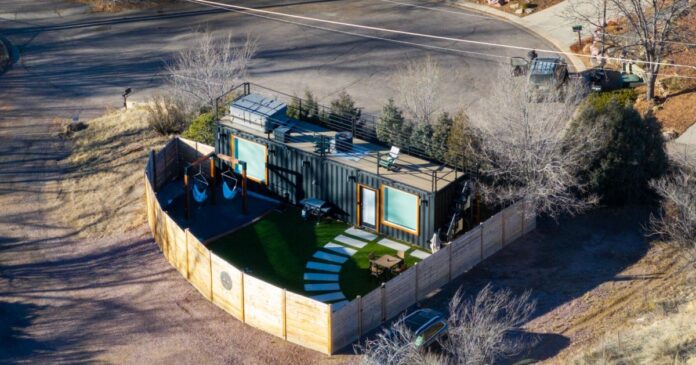The Shipping Container Saga: A Neighbor’s Fight Against an Unpermitted Rental Unit in Colorado Springs
Nestled at the end of a secluded road just north of Old Colorado City, a black shipping container has ignited an ongoing battle between neighbors and local authorities. What initially appeared to be a temporary installation for home renovation has transformed into a contentious issue involving property rights, city regulations, and community standards over the past 18 months.
A New Neighbor and a Surprising Delivery
In the spring of 2023, Thomas Helger and his wife, seasoned residents of the area for 25 years, were caught off guard when a large black box was delivered to a property across the street. The new owner of the house had recently started remodeling, and the Helgers assumed the container was either a temporary office or a dumpster for construction debris. However, their curiosity quickly turned to concern as they realized it was a shipping container, modified with windows and even a hot tub atop its roof.
The Helgers soon discovered the container had been listed on Airbnb for short-term rentals. This revelation raised alarm bells for Thomas, who expressed discomfort about renters having a clear line of sight into his second-floor bedroom and bathroom. “I don’t feel comfortable with that,” he remarked, highlighting the invasive nature of the rental situation.
A Long and Winding Complaint Process
Thomas Helger made his first complaint to the Colorado Springs code enforcement department in June 2023, initiating an arduous journey through the city’s bureaucracy. Over the next several months, Helger’s advocacy led to the removal of the listing from Airbnb and other rental websites. Yet, despite these small victories, the shipping container remained in its original spot due to a drawn-out negotiation process with the property’s owner, Michael Vialpando, and local government officials.
City Planning Director Kevin Walker explained the situation’s complexity, affirming that the container’s presence violated multiple codes pertaining to accessory dwelling units (ADUs). As per city regulations, unpermitted structures like this container cannot be situated so far forward on a property, nor can they exist without proper permits.
The Regulatory Web: Who Watches Over the City’s Growth?
The intricacy of managing accessory dwelling units in Colorado Springs involves multiple governmental departments. The Pikes Peak Regional Building Department oversees general building permits and safety standards, City Planning reviews zoning requirements, and Code Enforcement focuses on compliance and penalties for violations. This multi-tiered setup often leads to confusion and delays, as evidenced by Vialpando’s ongoing challenges.
Helger expressed concern over the efficiency of this regulatory framework, especially with impending changes to ADU permissions slated for next year. “If it takes this long to get a violation to comply with the law, then what will happen when this passes and we have 10, 20, maybe 100 times the number of units?” he pondered, sounding the alarm about potential complications for community oversight.
Adapting to Change: Variance and Future Regulations
In December, Vialpando filed an application for a variance permit to keep the shipping container in its current location. The application argued that the two-acre property had a larger front yard than many surrounding homes, suggesting that the yard’s size should influence adherence to ADU regulations. Vialpando maintained that the container’s design and landscaping enhanced the neighborhood’s visual character, echoing a sentiment that the structure might not significantly detract from community standards.
It is essential to note that even if Vialpando’s variance is granted, it does not render the shipping container a legal addition under the forthcoming regulations. Colorado Springs is expected to finalize an ADU ordinance early next year, dropping previous restrictions on construction locations but still prohibiting any accessory units from being positioned in front of the primary dwelling.
A Turning Point for Colorado Springs
As property owners and potential developers alike anticipate the city’s changing policies regarding accessory dwelling units, the Helger-Vialpando confrontation stands as a poignant example of the challenges that could arise. In a city that is rapidly evolving, residents are grappling with the tension between personal freedoms in property usage and the preservation of neighborhood harmony.
In the coming months, as Colorado Springs edges closer to enacting new legislation, the experience of the Helgers and Vialpandos will not only be a case study in local governance but also a clarion call for community engagement in urban development. The shipping container—a modest yet contentious structure—has become a symbol of the complexities and sometimes contentious nature of adapting to changing real estate realities in a growing city.














